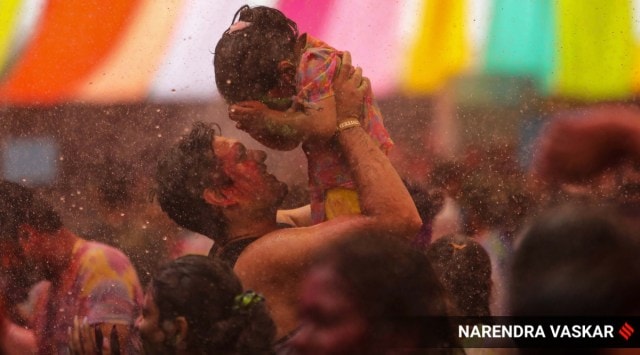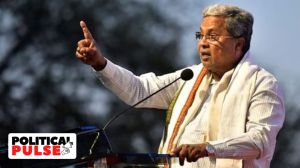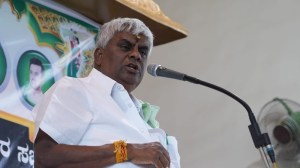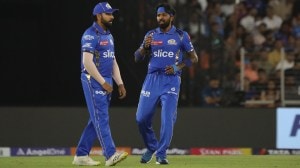- India
- International
Holi through the ages: A brief history of the festival of colours
The celebrations this time would be colourful, especially since the Holi festival in the last few years was hit by the Covid-19 pandemic. Holi marks the end of winter and the beginning of spring, and perhaps this year, the sentiment feels truer than ever.
 Holi, the festival of colours, is seen as heralding the beginning of spring. (Express photo by Narendra Vaskar)
Holi, the festival of colours, is seen as heralding the beginning of spring. (Express photo by Narendra Vaskar) The festival of colours is here, with different parts of the country kickstarting Holi festivities on Tuesday, which is the day of ‘Chhoti Holi’ or ‘Holika Dahen’. The main day of the Holi festival falls this year on March 8.
While people started celebrating with enthusiasm, police in different cities ramped up security arrangements. The Mumbai Police set up checks at various places in the city, to keep an eye on miscreants and incidents of drink-driving.
 Holi sees unbridled enthusiasm from all sections of society. (Express photo by Nirmal Harindran)
Holi sees unbridled enthusiasm from all sections of society. (Express photo by Nirmal Harindran)
In Delhi, police issued advisories on safe behaviour, while the Delhi Metro announced its schedule for the day well in advance.
The celebrations this time would be colourful, especially since the Holi festival in the last few years was hit by the Covid-19 pandemic. Holi marks the end of winter and the beginning of spring, and perhaps this year, the sentiment feels truer than ever.
Holi in mythology
On Holi, people come together and throw dry and wet colours on each other. They also play with water-filled balloons and water guns, with children especially enjoying the fun and frolic.

Apart from this, Holi also has a spiritual aspect, and it symbolises the triumph of good over evil. The myth behind the festival is that of the slaying of the Asura king Hiranyakashipu by an avatar of Lord Vishnu.
As the story goes, Hiranyakashipu earned a boon that he could not be killed either by a human or animal, neither indoors nor outdoors, neither at day nor night, neither on land, water nor air and not by any weapon.
Hiranyakashipu wanted everyone to worship him but could not convince his son Prahlada, who remained devoted to Lord Vishnu. The king then began to subject his son to cruel punishment. Prahlada’s aunt Holika tricked him into sitting on a pyre. But the cloak Holika was wearing to protect herself flew off and encased Prahlada, who survived. Meanwhile, Lord Vishnu appeared as the Narasimha avatar of half lion, half human at dusk, took the Asura king to the doorstep, placed him on his lap and killed him with his lion claws. The Holika fire signifies this victory of good over evil.
Another legend associated with the festival is that of Lord Krishna — another avatar of Lord Vishnu — and his consort Radha. In the Braj region, where Krishna is believed to have grown up, the festival is celebrated until Rang Panchmi, in commemoration of the divine love between Radha and Krishna. While dark-skinned Krishna once playfully complained to his mother about his complexion, she told him that Radha would like him as he is, and that he can even ask her to paint his face and hers in any colour of her choice. While Radha agreed to this, the colour that was on her face reflected on his and vice-versa. Thus, this was the occasion wherein Radha-Krishna became one, and came to be seen as a part of one another.
This is why Holi has a special place in popular culture as well. There are countless stories and songs of people setting aside their rivalries and problems on the occasion of Holi. There is a popular Hindi song whose lyrics reflect this sentiment: ‘Holi ke din dil khil jaate hain, rangon mein rang mil jaate hain’ (On the day of Holi, hearts bloom, colours mix with each other).
Holi: a window to India’s colourful side
Over the years, Holi has come to be synonymous with what non-Indians see as quintessentially ‘Indian’. Holi has fascinated foreigners across the ages, especially due to its connection with colours.
This story in The Indian Express says the first European rulers in India described the festival as “the carnival of the Hindus,” or the “Hindu spring festival in honour of Krishna, the amorous cowherd.” To them, Holi was representative of Hindu practices, Krishna and his flirtatious ways and, of course, the tradition of spraying colours.
For a long time, Europeans failed to grasp the correct spelling and pronunciation of the festival, and it was referred to as Houly, Huli, Whoolye and Wooly before the current spelling of the word was used in English dictionaries of the early twentieth century.
However, their documentation of the festival did not stop at describing the colours. They described vividly the multitude of ways in which different tribes, castes and communities of the subcontinent celebrated Holi. The accounts showed how fascinated they were with the colourful festivities.
Food and drink
Different regions of India have specific Holi dishes like gujia, but, other than the colours, nothing captures the spirit of the festival the way ‘bhang‘ does. Bhang is essentially a green-coloured paste made from seeds and leaves of the female cannabis plants — they have higher potency and Tetrahydrocannabinol (THC) content than their male counterparts. It is prepared by soaking and then grinding the plant material together into a paste, which is then rolled into smooth balls called bhang goli.
Some North Indian communities consume bhang with ‘thandai’, a cold beverage made from milk, sugar and an indulgent mix of nuts and species such as almonds, fennel seeds, watermelon kernels, rose petals, pepper, poppy seeds, cardamom and saffron.
The consumption of bhang on Holi also comes from mythology. Hindus believe that after Shiva’s wife Sati self-immolated, he went into a deep meditative state to overcome the grief. Parvati, who sought to bring him back to reality and marry him, went to the god of love, Kamadeva, for help. Despite knowing the dire consequences of disturbing Shiva during meditation, Kamadeva, on the day of Holi, shot an arrow laced with bhang at him and broke his trance. Although Shiva was enraged by the act and reduced Kamadeva to ashes, he ended up marrying Parvati. Believers consume bhang on Holi to celebrate Shiva’s return to the real world.
Holi, the Mughal way
Another research article in The Indian Express documents the hold Holi historically had over people belonging to different cultures.
While Mughal emperor Akbar’s participation is documented in court-affiliated biographies like the Akbarnama, his successors Jahangir and Shah Jahan are pictured in many miniatures as participating in the festivities.
The paintings and mushairas of the time showcases Mughal cosmopolitanism and its transcultural tryst, a signature of Indo-Persian times until Aurangzeb, which was later revived by Rangila (emperor Muhammad Shah’s popular name) and Bahadur Shah Zafar as well as provincial territories like Awadh.
Bahadur Shah Zafar (1775-1862), the last Mughal emperor, celebrated Holi with all zest. Called Eid-e- Gulabi, Holi was celebrated at the Red Fort, the official imperial residence, as gloriously as Eid. Bahadur Shah, himself a poet of finesse, wrote several special shayari to commemorate the occasion. Even in times of unabated decline, Zafar did not hesitate to bring on Holi as royally as ever.
Shahjahanabad would set off its days of celebrations marked by fairs, gatherings, mobile entertainers and musical performances by legendary courtesans. Holi has also had a special place in Sufism, with the festival being celebrated enthusiastically in various Sufi shrines.
May 03: Latest News
- 01
- 02
- 03
- 04
- 05




























